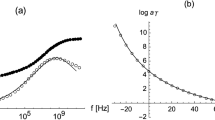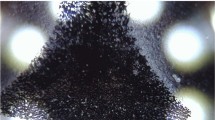Abstract.
We study the sliding friction for viscoelastic solids, e.g., rubber, on hard flat substrate surfaces. We consider first the fluctuating shear stress inside a viscoelastic solid which results from the thermal motion of the atoms or molecules in the solid. At the nanoscale the thermal fluctuations are very strong and give rise to stress fluctuations in the MPa-range, which is similar to the depinning stresses which typically occur at solid-rubber interfaces, indicating the crucial importance of thermal fluctuations for rubber friction on smooth surfaces. We develop a detailed model which takes into account the influence of thermal fluctuations on the depinning of small contact patches (stress domains) at the rubber-substrate interface. The theory predicts that the velocity dependence of the macroscopic shear stress has a bell-shaped form, and that the low-velocity side exhibits the same temperature dependence as the bulk viscoelastic modulus, in qualitative agreement with experimental data. Finally, we discuss the influence of small-amplitude substrate roughness on rubber sliding friction.
Similar content being viewed by others
References
D.F. Moore, The Friction and Lubrication of Elastomers (Pergamon, Oxford, 1972).
B.N.J. Persson, Sliding Friction: Physical Principles and Application, 2nd ed. (Springer, Heidelberg, 2000).
B.N.J. Persson, J. Chem. Phys. 115, 3840 (2001).
B.N.J. Persson, A.I. Volokitin, Phys. Rev. B 65, 134106 (2002).
M. Klüppel, G. Heinrich, Rubber Chem. Technol. 73, 578 (2000).
A. Schallamach, Wear 6, 375 (1963).
Y.B. Chernyak, A.I. Leonov, Wear 108, 105 (1986).
A.E. Filippov, J. Klafter, M. Urbakh, Phys. Rev. Lett. 92, 135503 (2004).
Weak absorption systems (e.g., saturated hydrocarbon molecules or noble-gas atoms on metal surfaces) exhibit extremely low (pinning) barriers for parallel motion. The barriers can be estimated from the measured frequencies of parallel adsorbate vibrations, see. e.g., B.N.J. Persson, Surf. Sci. Rep. 15, 1 (1990).
M.L. Williams, R.F. Landel, J.D. Ferry, J. Am. Chem. Soc. 77, 3701 (1955).
B.N.J. Persson, Phys. Rev. B 51, 13568 (1995).
B.N.J. Persson, O. Albohr, G. Heinrich, H. Ueba, J. Phys. Condens. Matter 17, R1071 (2005).
B.N.J. Persson, E. Brener, Phys. Rev. E 71, 036123 (2005).
B.N.J. Persson, Surf. Sci. 401, 445 (1998).
A. Schallamach, Wear 17, 301 (1971).
A.D. Roberts, A.G. Thomas, Wear 33, 45 (1975).
K. Vorvolakos, M.K. Chaudhury, Langmuir 19, 6778 (2003).
U. Tartaglino, V.N. Samoilov, B.N.J. Persson, J. Phys. Condens. Matter 18, 4143 (2006).
B.N.J. Persson, Surf. Sci. Rep. 61, 201 (2006).
B.N.J. Persson, Phys. Rev. B 63, 104101 (2001).
B.N.J. Persson, J. Phys. Condens. Matter. 18, 7789 (2006).
The force acting on a stress domain should depend quasi-periodically on the lateral displacement $x$ i.e., $F = F_{\ab{c}}\sin(2\pi x/a)$ giving for small $x$: $F\approx F_{\ab{c}} 2 \pi x/a$. The pinning stress $F_{\ab{c}} = \sigma_{\ab{c}}D^2$ and the elastic force $F=kx$ with $k = \alpha ED$, where $\alpha$ is of order $\sim 6$. Thus we get $ED \approx \sigma_{\ab{c}} D^2/a$.
A. Le Gal, M. Klüppel, J. Chem. Phys. 123, 014704 (2005).
K.A. Grosch, Proc. R. Soc. London, Ser. A 274, 21 (1963)
A. Casoli, M. Brendle, J. Schultz, A. Philippe, G. Reiter, Langmuir 17, 388 (2001).
T. Baumberger, C. Caroli, Adv. Phys. 55, 279 (2006)
M.R. Mofidi, E. Kassfeldt, B. Prakash, to be published in Wear.
J. Molter, Elastomerreibung und Kontactmechanik, DIK fortbildungsseminar, Hannover 2003.
D. Forster, Hydrodynamic Fluctuations, Broken Symmetry, and Correlation Functions (Benjamin, London, 1975).
Author information
Authors and Affiliations
Corresponding author
Rights and permissions
About this article
Cite this article
Persson, B.N.J., Volokitin, A.I. Rubber friction on smooth surfaces. Eur. Phys. J. E 21, 69–80 (2006). https://doi.org/10.1140/epje/i2006-10045-9
Received:
Accepted:
Published:
Issue Date:
DOI: https://doi.org/10.1140/epje/i2006-10045-9




